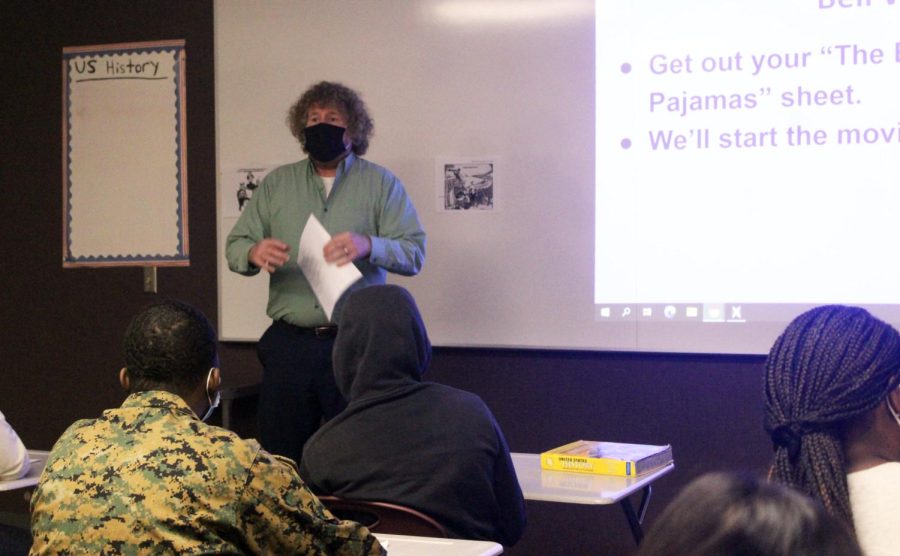Explaining critical race theory
U.S. history teacher Ron Browning starts class. Browning says crticial race theory is not taught in any high schools he is aware of.
January 24, 2022
The thing is that there’s no evidence that anyone is trying to or currently teaching Critical race theory in any k-12 schools in the United states. But what I can’t say is that it’s not being taught in any schools whatsoever.
Those are the sentiments of Ron Browning, who specializes in teaching U.S. history and social systems. Critical race theory is a theory used in some law school classes that explores the way structural racism is embedded in laws and institutions in America. It is a wide-ranging subject that looks at how the system is created and maintained to give some groups distinct advantages over minority groups and marginalized people whether those advantages are intentional or not.
Now that we’ve established that CRT is a subject designed specifically for instruction in higher education — more specifically in law schools where they have every reason to explore how laws work/have worked — let’s try to understand what people are really trying to keep out of k-12 curriculums and why it’s been such a hot topic for the last couple months.
Critical race theory has become a buzzword and debate prompter between all sides of the political aisle. Legislative and ideological debates on whether this topic should be taught to children have been so heated, despite it not even being widely considered in the education world, for multiple reasons.
One of them, according to Browning, being a lack of accurate understanding of what the term truly means. For the most part it’s simply people believing they’re fighting for something that doesn’t even exist. And it’s understandable for some to be angered by the concept of their children being taught that they’re the devil for being white, and they need to feel guilty for existing in their skin. But fortunately that’s not what is happening, or will be happening, anytime soon.
What is happening however, and what the other half of people who aren’t simply ill-informed are fighting against, is the teaching of American history from an accurate well-rounded perspective. According to Browning, if students are not taught a complete, accurate, version of American history from multiple perspectives, then they are not learning true history.
The United States, like all countries, has a rich history, and unfortunately not all of that history is positive. Failing to learn the true history — good and bad — of our country can lead to some of the same mistakes being repeated. When we recognize that what many are actually fighting against is the provision of a comprehensive education. And that critical race theory is a term that has been co-opted by some groups to describe anything that has to do with racism or inequality. We start asking the real questions.
Now if the question is: Should diversity, equity, inclusion, history from the African American perspective, Native American perspective, Immigrant perspective, and all perspectives, be taught in schools, in all grade levels? Then it’s hard to argue that the answer to that is no. Many white supremacist and people who’d rather live with their ignorance know this, so instead they vilify the simple provisions of accurate information.
The argument is that if white students learn about structural racism and the horrors of slavery and segregation, it will make them feel guilty. I’d prompt anyone who feels anything but empathy and a push to understand different perspectives when they are taught these topics, to evaluate why they feel that way about a crime they never committed.
If you truly don’t exhibit or believe the actions and ideologies that are being questioned and discussed. Why do you feel as though you’re being called out? And if after some sincere evaluation you realize you do have some areas you could grow in, the route to be taken isn’t the one of guilt-tripping yourself, as that does no one any good. Instead, realize everyone is a product of society in some way, and consider taking steps towards dismantling those ideas and behaviors you’ve inherited most likely from your environment.
One significant issue the boogeyman-ification of critical race theory has created is making the accurate education on U.S. history a partisan topic. The topic of racial inclusion and education, in order to understand our society and avoid future repetition of past mistakes, shouldn’t be partisan.
It should not be difficult to admit that racism exists, that it is bad, and that all perspectives need to be considered. Because many Americans haven’t learned about racism in full, growing up only seeing history from a European descendant’s perspective, and have never experienced it themselves, many don’t believe it is a problem or know what the full history really consists of. This is a problem that can only be resolved by a well-rounded history curriculum and education system.
According to Browning, he and many other social studies and History teachers simply teach history from multiple perspectives.
“I don’t just look at history from the perspective of people who look like me,” he said. “I also try to teach my students critical thinking skills, and empathy. If someone sees that as me teaching CRT, well, they are uninformed.”
He also mentions that since he doesn’t teach in law school he will not be teaching critical race theory, but will continue to teach about race, racism, equity, diversity and inclusion in his classes.
Browning sums all of this up really nicely by adding that it is “important for all students to see themselves – regardless of race, religion, national origin or sexual identity – in the lessons that are taught in class.”
And he is absolutely correct. That is the America that began more than 200 years ago and that is the United States we all deserve.













Seliat YEKINNI-ELEBUTE • Jan 25, 2022 at 3:59 PM
Go girl!!! So proud of you❤️🌺